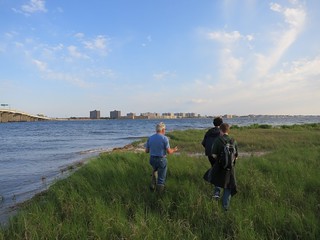
June 12, 2012 By Christian Murray
Jamaica Bay, an estuary located at the southern tip of Queens and Brooklyn, is undergoing a rival, despite being the city’s long-time sewerage dump, according to Sunnyside resident Dan Hendrick who is in the midst of filming a documentary on the area.
Hendrick, a popular Sunnyside figure, said his documentary will take a more positive tone toward Jamaica Bay. He said his film will recognize the Bay’s environmental struggles, while pointing to its promising future.
Hendrick’s optimism has been spurred on, in part, by the financial support that is being provided by New York City and the federal government to help clean the waterway. This funding continues to finance the restoration of marshes and improvements in the sewage system.
“This estuary is not nearly as polluted as it once was, or nearly as polluted as many fear it is,” Hendrick argues, who claims he would eat fish from this body of water. Hendrick, a strong environmentalist, says there are many signs the Bay is making a comeback.
“It is horseshoe crab mating season right now and the water is filled with them. Yet, so many people are down on Jamaica Bay,” he said, adding, “They see the negative, yet the water quality is getting better and it is safe.”
Hendrick, who grew up in the suburbs of Detroit, became interested in Jamaica Bay after working as a reporter at the Queens Chronicle. Hendrick covered southern Queens —before becoming editor-in-chief — and began investigating the people and issues at the Bay.
At the time, Hendrick went to the library to conduct research on the Bay, yet little (and certainly no general readership book) had been written on the subject before. Hendrick, who came to New York to go to Columbia University many years ago, then proceeded to write that book. It was called “Jamaica Bay” and was published in 2006.
Today, Hendrick is the communications director at the New York League of Conservation Voters. He has continued to research Jamaica Bay and decided—with $3,000 of his own funds—to start putting together his film—to be called “Jamaica Bay Lives.” He is working with David Sigal, who is directing the documentary.
The two men have had preliminary discussions with WNET/Channel 13, and are also hoping to distribute the film through PBS, National Geographic and the Sundance Channel. Hendrick would also like to target film festivals. The aim is to complete the film by the end of 2012.
Jamaica Bay has had a tough century, according to Hendrick. Around 1900, the Bay was viewed as being home to some of the best oyster beds on the East Coast. However, “it became the toilet bowl for Brooklyn and Queens [south of Grand Central Parkway],” he said, where vast quantities of untreated sewage began pouring into the Bay.
Shortly afterward, a ban on shellfish went into effect.
The opening of two airports in the 1930s and 40s further complicated its environmental health, Hendrick said. Two airports were constructed—the Floyd Bennett Field and Idlewild Airport (later renamed JFK Airport in 1963)—which resulted in thousands of acres of marshland being lost. Meanwhile, five landfills opened around the Bay’s perimeter. Even today, four sewage plants spew around 250 million gallons of nitrogen and large amounts of chlorine into the water every day.
Today, “Jamaica Bay is 50% of the size of what it used to be,” Hendrick said.
However, Hendrick says the area is on the verge of a renaissance.
In 2005, the city signed the Jamaica Bay Watershed Protection Plan, which aims to increase water quality and make the bay safe for the wildlife.
In February 2010, the city said it would commit $100 million to install new nitrogen control technology at the sewage treatment plants and $15 million to restore the dying marshes. When the upgrades go into full effect, it should reduce nitrogen discharges by 50%.
The U.S. Army Corps of Engineers, together with state and city agencies, has launched a $19 million project to rebuild 40 acres of lost marshland. The marsh will filter chemicals, stabilize the shoreline and provide habitat for plants and fish.
Furthermore, a $400 million plant in Brooklyn was opened in 2011 to capture the sewage and storm water runoff that has been flowing into the Bay during rainstorms.
Hendrick said that the time is right for city residents to make better use of the Bay. He said there should be more activities available there, such as kayaking and camping, as well as better access and transportation links.
However, all bets could be off if JFK is expanded to include two additional runways—with one being 2 miles long and the other jutting straight into the bay.
Currently the land is protected by the government. “It’s the only national wildlife refuge in the country you can get to by subway,” Hendrick said. In 1972, much of the Bay was transferred to the National Park Service as part of the new Gateway National Recreation Area.
However, the passing of legislation in Washington could overturn the protections the Bay enjoys now.

2 Comments

Everyone needs to pay more attention to our waters. Don’t think the water utilities are “paid” to take care of “stuff like that”. I grew up in Rockaway Beach with Jamaica Bay as my backyard. Since that long ago time, the quality of the most important resource to life has degenerated.
Do you know where your drinking water comes from? In Nassau and Suffolk (the other parts of Long Island shared with Queens and Brooklyn) the sole source of drinking water are the underground aquifers. Serious problems on the horizon for them. Salt water intrusions will turn the babies’ bathwater into pickling brine.
Hurrah! for Dan Hendrick.
And I can not tell you how sick to death I am of Queens being used as the world’s traffic island. Enough.